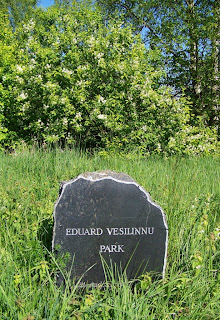But who was Konstantin Päts?
When our family was in the displaced persons camp in Germany it was common to see in private and public places a picture of a dour looking old fat guy with medals on his chest. I remember that my father venerated him, and that his feelings were shared by the other Estonians in the camp. Konstantin Päts was someone very special to them.
Päts (the name means a small loaf of bread, attesting to his humble Estonian background) led an incredibly turbulent and interesting life. He was born in 1874 and grew up in the town of Pärnu, and then finished his law degee at Tartu University. Next he went into the Russian army and fought with the Tsar’s troops. He came back to
The Estonians had no experience in self-governance. They bickered and fought among themselves, searching for something that everyone could agree on. There was no constitution as such, and there wasn’t even an office like president. "Riigivanem" was the closest they came to that, and that simply implied that the holder of this office was the guardian of the country. They were deathly afraid of strong leadership, very much like the American forefathers feared having a king.
In the early 1930s, given the turbulent politics and the effects of the global depression, many people looked to Germany for political guidance. The fascist movement in Estonia became powerful, and these people tried to recruit Päts to be their leader. Päts instead decided to declare a state of emergency and to govern with dictatorial powers. He then dissolved the fascist party and put their leaders in jail. This ploy worked, and the years that followed, the late 1930s, was a period of stability and economic growth. But Päts did not want to be a dictator, and pushed through a new constitution, based on the Belgian model, that severely curtailed his own powers. He wanted the country to go back to being a true democracy. And true to his word, by 1938 the new constitution was in place and the country no longer had a dictator with emergency powers. It did not surprise anyone that Konstantin Päts was democratically elected the first president of Estonia. This has to be one of the few times in the history of the world where a dictator has stepped down and received the eternal gratitude and love of the country.
The boom time was cut short by the invasion of the Russian army first in 1939, and then by the full-scale takeover in 1940, culminating in the Red Terror. Päts was of course arrested and taken to
In 1991, after regaining independence, Estonia negotiated with Russia to bring back the remains of Konstantin Päts so that the country could provide him a proper burial. But the event was more personal than national, and his grave is starkly unimposing. A simple stone.
Outside of Estonia Konstantin Päts is basically unkown. If you Google his name, you get almost nothing in languages other than Estonian. Even in Estonia there are few portaits of him in public places, and I have yet to see one in a private house. There are no cities or states or even streets named after him, and most certainly there is no huge monument attesting to his role as the father of the country. And yet Estonia would not exist if he had not been willing to devote his own life to the young nation and had not taken unimaginable risks in its behalf. He was quite a guy. He had sisu.
-- Aarne



























